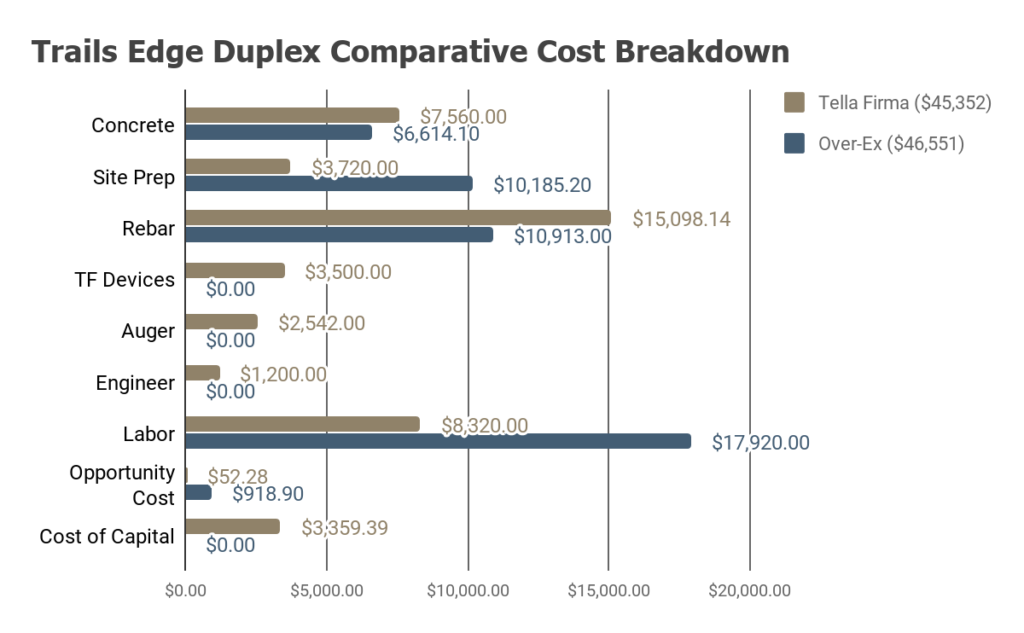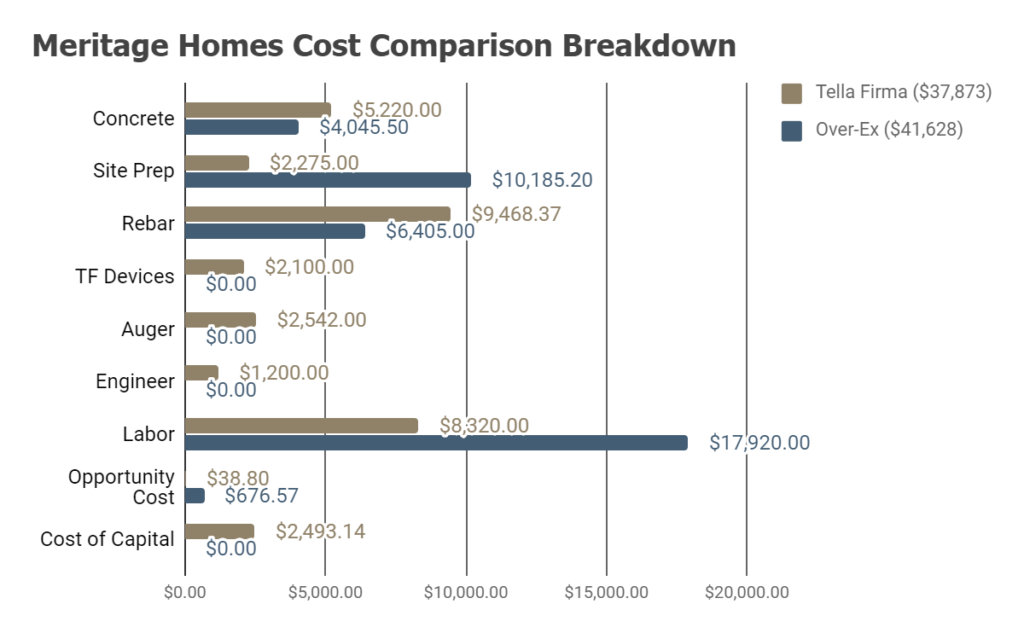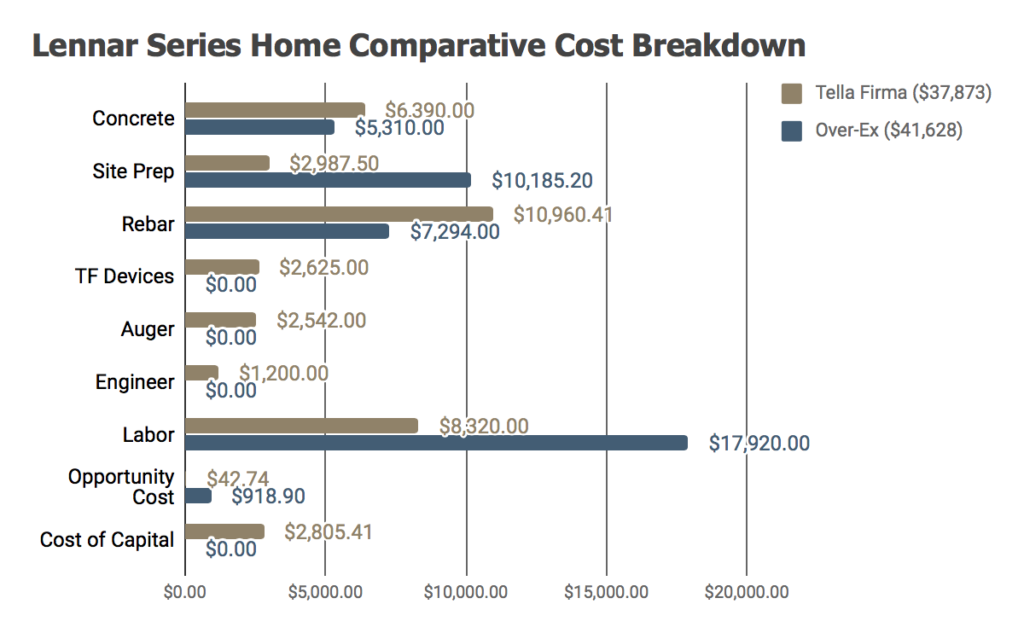With the foundation designs complete, the team can now estimate the total cost of using a Tella Firma foundation and compare it to the incumbent over-excavation process. The first step in this comparison is determining which costs are likely to change and which will stay the same when transitioning from over-excavation to Tella Firma. It is obvious that the cost of over-excavation will be removed, as that is the purpose of using the Tella Firma system. There will also no longer be the need for a typical slab on grade foundation. That cost will be replaced by a post tensioned, elevated slab foundation, which is a staple in the Tella Firma system. With this more technical foundation, additional engineering oversight is required, which is an added cost to the system. Finally, the Tella Firma foundation requires the introduction of two entirely new costs: drilled piers and the physical Tella Firma lifting mechanisms. Both of these items will incur substantial costs to the project.
Some costs will remain but change substantially in value, which also must be considered in the cost analysis. The amount of rebar used in the foundation will change to accommodate the new type of foundation system being used. The project schedule will also change significantly, which is related to price through the opportunity cost of liquid capital and the cost of labor.
Other costs will not be affected at all by the change from the over-excavation process to the Tella Firma system. A geotechnical report of the site is required in either situation, as is permitting for the development. The Tella Firma foundation is not usable for infrastructure, so roads and utilities will still need to be over-excavated. Since the team only received data on the costs to over-excavate the residential lots, it can be assumed that the cost to over-excavate roads and utilities is independent of this analysis and will not change materially. Lastly, formwork is required for a concrete slab, no matter what foundation type is used. For simplicity, it is assumed that the formwork cost for over-excavation is identical for the formwork cost for the Tella Firma slab. Table 7 provides a breakdown of the cost assumptions just discussed.
Table 7: Cost Comparison Breakdown
| Costs Saved | Costs Incurred |
|
|
| Costs Unchanged | Costs Changed |
|
|
The cost comparison between over-excavation and Tella Firma was calculated using a unit price method. By using a unit price method, the same price assumptions could be used for across each foundation design. The assumptions used to calculate the unit price for each component of the cost comparison are outlined below.
Over-Excavation: The unit price for over-excavation was determined based on the price paid by Sterling Ranch to over-excavate the residential lots on Filing 3. The average cost was reported to the team as $2.75 per cubic yard of over-excavated soil. This price tag covers all costs of the over-excavation process. It does not, however, include the cost to over-excavate utilities to the residential lots. As mentioned before, utilities and the roadways they run under will have to be over-excavated in the Tella Firma process as well. For this reason, it benefits the analysis to not include utilities or roads in the over-excavation price and allow the cost comparison to be completely independent of this process.
A benefit of over-excavation is that the building site can be prepared for construction while the soil is also being remediated. Without over-excavation, there is an additional need for site preparation before the Tella Firma foundation can be built. This site preparation is minimal, such as removing trees or debris and setting the grade, but it is not free. Site preparation for the Tella Firma process is estimated at $1.25 per square foot of land.
Standard Foundation: The cost for a standard foundation was broken down into two material components: concrete and rebar. Concrete is estimated at $90 per cubic yard while rebar is estimated at $700 per ton. The cost of both concrete and steel can vary significantly based on geographic location and economic cycles. As the two primary components of a foundation system, a drastic swing in the price of concrete or steel could change the outcome of this cost analysis and should be monitored closely.
Pier Drilling: The presence of piers in the Tella Firma foundation system contributes to a need for additional concrete and steel reinforcing. It also creates a need for an auger to drill the holes for the piers. In a conservative estimate, it is assumed that a truck mounted auger is rented for an entire day for each Tella Firma foundation that is built. This cost comes to a price of $2542 per 8-hour workday.
Post Tension Foundation: The Tella Firma foundation requires the same type of concrete and rebar used in the standard foundation. These unit prices will remain constant at $90 per cubic yard of concrete and $700 per ton of rebar. The Tella Firma foundation also uses post tension reinforcing, which is a different steel and comes at a higher cost. The cost for post tension cables is estimated at $1.65 per pound.
Tella Firma Lifting Mechanism: The technology that makes the Tella Firma foundation successful is the proprietary lifting mechanism that connects the piers to the concrete slab. A lifting mechanism is needed at each pier location so design is key to minimizing the total cost through the number of piers and lifting mechanisms. RMG Engineers advised the team that each Tella Firma lifting mechanism will cost $175 per mechanism when bought in bulk.
Engineering Oversight: The complexity of a post tension elevated slab foundation requires engineering oversight that is not necessary with a standard slab on grade foundation. An engineer will be present at the stressing of the post tension cables as well as the lifting of the slab. The engineer’s time is estimated at a final cost of $150 per hour. This price will also be highly variable based on locality and the firm chosen to oversee the design process.
Rebar: As mentioned, the amount of rebar needed changes based on the type of slab being used. The Tella Firma slab is primarily reinforced by the post tension cables, so it will likely need less standard rebar than the traditional slab. On the other hand, the piers in the Tella Firma foundation will require additional rebar, unless they are designed as plain concrete piers. This means the quantity of rebar needed will factor into the cost comparison but it does not change the unit price for rebar, which is taken at $700 per ton.
Schedule: One of the big claims of the Tella Firma technology is that it can save considerable time over the over-excavation process (A schedule comparison is presented in the next section). Since time is valuable, this schedule difference is also considered in the cost comparison, in the form of opportunity cost. Opportunity cost is calculated as the interest that could be made if the total cost of the project was invested in the market rather than the project, for a time equal to the project timeline. The investment vehicle chosen to represent the market was conservatively taken as the average annual rate on a 30 year mortgage, approximately 3.5%. No compounding was considered. For example, the opportunity cost of a project that cost $100 and took half a year to complete would be 100*(1+(0.035/2))-100 = $1.75. In this case, each foundation was considered as its own project, independent of the rest of the development process.
Labor: Labor is another time related cost; the construction workers must be paid for each day of construction. The cost of over-excavation includes the labor of that process, so labor in this analysis only represents the crew working on the foundation. For simplicity, it was assumed that both foundation types require the same daily manpower. This manpower was estimated using a 5 man crew with each member getting paid an hourly wage of $16.00. For an average 8 hour work day, this results in a total daily labor cost estimate of $640.00.
Cost of Capital: Cost of capital is the cost associated with taking a risk on a new investment such as the Tella Firma foundation. Cost of capital serves as a hurdle rate of return on investment; if the rate of return on the Tella Firma foundation is greater than the cost of capital, it is worth pursuing. If not, there is not enough incentive to go through the trouble of changing to the new process.
The cost of capital rate was provided by Sterling Ranch at 8%. This rate was factored into the cost comparison by multiplying the total cost of the Tella Firma foundation times (1 + cost of capital rate) or 1.08. This weighted Tella Firma cost is then compared to the unweighted cost of over-excavation. If the Tella Firma cost is still cheaper than the over-excavation cost, it has overcome the cost of capital rate and should be pursued.
Cost Comparison (Schedule)
With several costs dependent on the project schedule, it is important to get an accurate representation of the total time needed to build a foundation using the over-excavation method and the Tella Firma method.
Over-excavation followed by a traditional slab on grade foundation is a lengthy process. Based on the experience of previous Sterling Ranch filings, over-excavation takes about six months to complete, only after which can the foundation construction begin. Over-excavation is done all at once so, following the six month process, all lots in a filing are ready for foundations. Additionally, grubbing and grading can be completed during the over-excavation process, removing the need for future site preparation. Still, the traditional foundation process takes around 4 weeks. This adds up to a total over-excavation timeline of 210 days from the day ground is broken until the day a lot is ready for framing above the foundation.
The Tella Firma process requires no over-excavation, so six months was quickly cut off the schedule. The Tella Firma process then comes down to seven main steps, which are detailed in Figure 4. The first step is site work, which includes clearing debris from the site and preparing it for construction; this takes 1-2 days. Step two is to drill the holes for the foundation piers. It was conservatively estimated that this would take 1 day per lot. Next, the piers must be reinforced and poured. Since the soil is the form, the process can continue once the piers have set enough to support the installed Tella Firma lifting mechanisms, approximately 3 days after the piers were poured. The next 2 days are spent preparing for the slab. This is when formwork is installed and post tension as well as standard rebar installed.
Step 5 is to pour the slab, which is estimated to take 1 day. Then the concrete slab must cure. Tella Firma foundations utilize post tensioning, which allows the slab to be lifted away from its formwork a few days after it is poured. This saves precious time over traditionally reinforced, elevated structures. After only 3 days of curing, the post tension cables can be stressed and the slab lifted. These two steps can be completed in the same day, bringing the total timeline of a Tella Firma foundation to 13 days from groundbreaking to start of framing.
Several steps of the foundation process require good weather, such as pouring the slab. Inclimate weather can delay the foundation process. However, the effects are the same on both the over-excavation and Tella Firma foundations. While these estimated schedules cannot be taken as guarantees of the foundation timeline, they are comparable.
Final Cost Estimates
The final step in the cost analysis is combining the foundation design with the unit price estimates and schedule estimates to prepare a final cost estimate of the Tella Firma foundation. By designing the size of the slab and piers needed to structurally support each house, the team has also determined the amount of each material that will be needed in the cost estimate. A simple calculation of material needed times unit price creates a total cost of the Tella Firma foundation broken down by component. These cost breakdowns are shown in Figure 1, 2, and 3. These graphs show exactly which aspects of Tella Firma are financially beneficial compared to over-excavation, and which aspects are not.

Figure 1. Trails Edge Duplex Cost Comparison

Figure 2. Meritage Homes Cost Comparison

Figure 3. Lennar Series Home Cost Comparison
